What to Do in the Event of a Roof Leak
With the current rainstorms passing over Arizona and the Phoenix valley, many are discovering roof leaks they didn’t know they had. One of the biggest questions that people have is “Does my insurance cover this?”. The answer is yes, and no, depending upon the cause of the leak.
Roof Leaks and Insurance Coverage
Homeowners insurance is designed to cover sudden or accidental damage to your home, but does not generally cover damage caused by maintenance issues. Roof leaks can be and are caused by both, so knowing if a roof leak is a covered loss normally takes the inspection and review of both a contractor and the insurance company. The contractor can deduce the source and cause of the leak, while the insurance company interprets the coverage laid out in the policy to see which category the damage falls under. From there, a determination of coverage is made.
The next question that arises is what is considered sudden or accidental damage.
Sudden and Accidental Damage Generally speaking, sudden and accidental damages are caused by things outside of the homeowners control. The following is a small list of things to give you an idea of what sudden and accidental damages are.
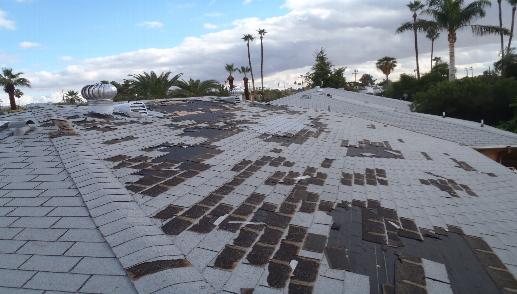
- Severe Weather, including high winds, hail, and driving rain
- Flying debris from storms
- Falling debris from any number of sources
- Felled trees
- Vehicle collision
Now this list is by no means all inclusive, and your particular insurance policy may have specific exclusions for any number of the above listed items, which could deem them fully, partially, or not covered under the limits of your policy.
Maintenance Issues
Now we come to the other side of the coin, what are not considered sudden and accidental, and that may have limited or no coverage. Again, we’ve assembled a quick list for you. Remember that this is a general guideline, and not a hard and fast set of rules. Your specific policy may cover one or more of the following, or there may be mitigating circumstances that allow your claim to be partially or fully covered.
- Roof aged beyond normal usable condition (i.e., a ten year roof with 25 years of service) has begun to leak
- Roof not maintained (debris collected on roof for a long period of time, gutters full, damaged shingles not repaired in a timely manner or at all)
- Pre-existing conditions that may hve been disclosed or discovered during the purchase of the home, or during the inspection by the insurance company when writing the policy
- Varmints and pests such as pigeons, roof rats and termites, to name a few
- If possible, avoid working on the roof during a rainstorm.
- NEVER work on the roof during a thunderstorm or during high winds.
- Make sure your ladder is sturdy and secure befor
- Be aware and beware of power lines and trip hazards while on the roof.
- Always work with at least two people, this is for safety and efficiency.
- If you or your partner have an issue with heights, do not climb onto the roof.
- Long term water damage can rot away the subdeck of a roof and leave it weak. Walk cautiously on the roof and test out all areas before stepping on it with your full weight. Rotted subdecking can give way, and many a professional roofer has fallen through a roof and been seriously injured or worse.
- Ceramic and concrete tile roofs are very delicate, and break easily while being walked on. Take great care, and never walk on these types of roofs when wet, they are extremely slick.
- If possible, cut your battens on ground level. This reduces the chance of making cuts in a precarious position.
- Stage all the necessary tools and materials on the roof prior to starting, it is very tiring to constantly have to climb up and down a ladder.
- Call a professional contractor if you are not comfortable performing the tarp up yourself.
Remember that a roof is designed to be a barrier between the interior of the home and the heat, cold, rain, and snow during normal weather events, and normal wear and tear is expected because of this. It is the homeowners responsibility to periodicaly inspect the condition of the roof and clean and maintain it. Damages that arise from a failure to do so may not be covered under your insurance policy. You may be covered under certain home warranties, home maintenance agreements, or material or workmanship warranties provided by the installer or manufacturer.
Now What?
During a rainstorm, it is hard to determine the actual cause of a leak right away and even more difficult to know if it will be a covered insurance claim. Many homeowners, especially in our current economic situation, don’t have the money to pay for a new roof if the repairs are not covered by their insurance. To further exasperate the situation, the water from the roof leak can damage the interior ceilings, walls, flooring and belongings of the homeowner if left unchecked and unattended.
How can you protect your home from further damage, without immediately committing to thousands of dollars in roof repairs with no assurance of where the funds will come from?
Temporary Roof Tarping
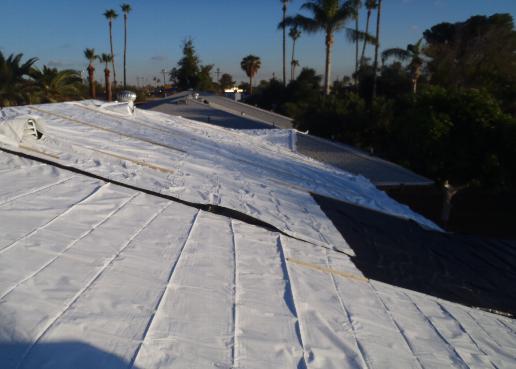
Many times, a simple tarp fastened down over the damaged area can slow or stop the immediate damage from continuing and allow you to schedule an inspection with your insurance company and a qualified contractor to pinpoint the source of the leak and determine coverage. This will also allow you time to receive competitive bids from multiple contractors prior to authorizing any repairs to make sure you are getting a consistent evaluation and a fair price.
Depending upon the size of the area needing to be tarped, the initial cost of materials can range from around $40 for a small area covered with a single tarp, to around $200 or more for a large area with multiple tarps. This is the do-it-yourself cost. If you need to call in a contractor to perform the tarping for you, expect prices to start from around $300 and increase from there depending upon size and complexity.
An average quality tarp up will normally weather the storm and last for a couple of weeks. A high quality tarp up can last several storms and several months, depending upon the materials used and the manner of installation. Do remember, though, that no matter how well a tarp is installed, if a severe weather event has the force to damage a roof, it has the force to damage a tarp.
Board Ups of Windows and Doors
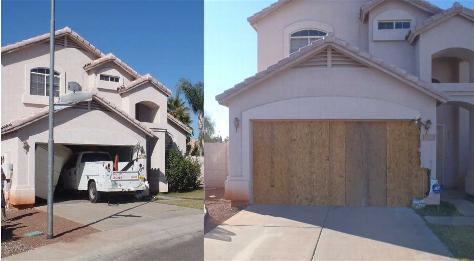
Doors and windows are damaged just as much, if not more often, than roofs. Not only can severe weather damage doors and windows, but criminals, such as vandals and burglars, may break a door down. Windows are often broken by errant baseballs, golfballs, and even rocks thrown from a lawnmower. With an average wait time of 3 to 5 days to replace a window or door, or up to 3 weeks or more for special orders, it is important to board up the opening to secure it against inclement weather, varmints, and opportunistic robbers.
Tips for the Do-It-Yourselfer
The following list is just some quick notes to keep in mind when attempting to tarp a roof yourself.
e attempting to climb onto the roof. Inspect it for any defects or damage before using, and please read up on proper ladder usage.
Damage from Water Intrusion
The reason roof leaks are such a nuisance is because of the damage the water causes to the roof and the interior of the home. While minor water damage can be cleaned up and dried with minor inconvenience, major or prolonged water damage can cause serious issues and major repairs, including replacement of damaged drywall, insulation, flooring, and possibly mold remediation.
In order to minimize the damage caused by a roof leak, it is important to stop the source of intrusion (roof tarp), identify the water damaged areas, and begin cleanup and dryout procedures as necessary, and as soon as possible. Water continues to cause damage to building materials the longer it is allowed to dwell, and will spread out and affect a larger area as it seeks equilibrium. A professional water damage contractor can assist you in the cleanup, dryout, and repairs to your home or building.
We’ve included this link to the EPA’s website about mold and moisture in your home to give you some guidance, and help you in deciding whether to use a mold and water damage contractor to assist you:
Familiarize yourself with your insurance policy, most policies have a clause stiplulating that the property owner is responsible for mitigating damages, regardless if the insurance company has reviewed the loss yet. This means your insurance company expects you to take proactive steps to stop the spread of damage, and some companies may not extend coverage to damage they believe could have been prevented. Talk to your agent or adjuster to find out what is expected from you.
Final Thoughts
We hope you’ve found this blog useful and informative, and remember, it is not meant to be a rule book, but a guide to assist you. If you are unsure about the coverage your insurance policy extends, contact your insurance agent and they will be happy to go over it with you and explain what may or may not be covered. They may also be able to offer you additional insurance to fill any gaps in your coverage.
If you find yourself in need of any tarp up, board up, water, fire or mold damage restoration, or any other type of property damage, please feel free to contact us and we will be happy to assist you.









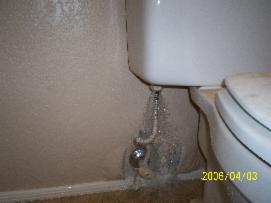 can cause severe damage to walls, cabinets and flooring. On average, a 1/2″ pipe, depending on water pressure, will release between 14-21 gallons per minute.
can cause severe damage to walls, cabinets and flooring. On average, a 1/2″ pipe, depending on water pressure, will release between 14-21 gallons per minute.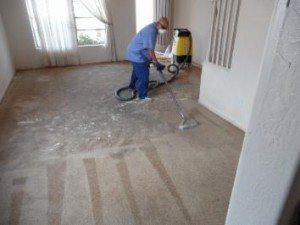 minimize the damage, it is important to act quickly. By removing standing water, it stops the spread of the water and reduces the amount available to soak into the walls and furniture.
minimize the damage, it is important to act quickly. By removing standing water, it stops the spread of the water and reduces the amount available to soak into the walls and furniture.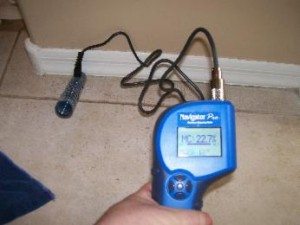 of meters to measure the moisture content of building materials helps to determine the affected area of a flood damaged building.
of meters to measure the moisture content of building materials helps to determine the affected area of a flood damaged building.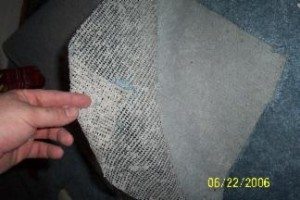 allowed to stand, the further it can spread and the more damage it causes.
allowed to stand, the further it can spread and the more damage it causes.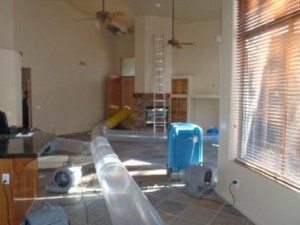 has been completed, it is then time to setup the drying equipment. Depending upon the size of the job, this can range from a single fan, multiple dehumidifiers, air movers, and specialty drying equipment.
has been completed, it is then time to setup the drying equipment. Depending upon the size of the job, this can range from a single fan, multiple dehumidifiers, air movers, and specialty drying equipment.



